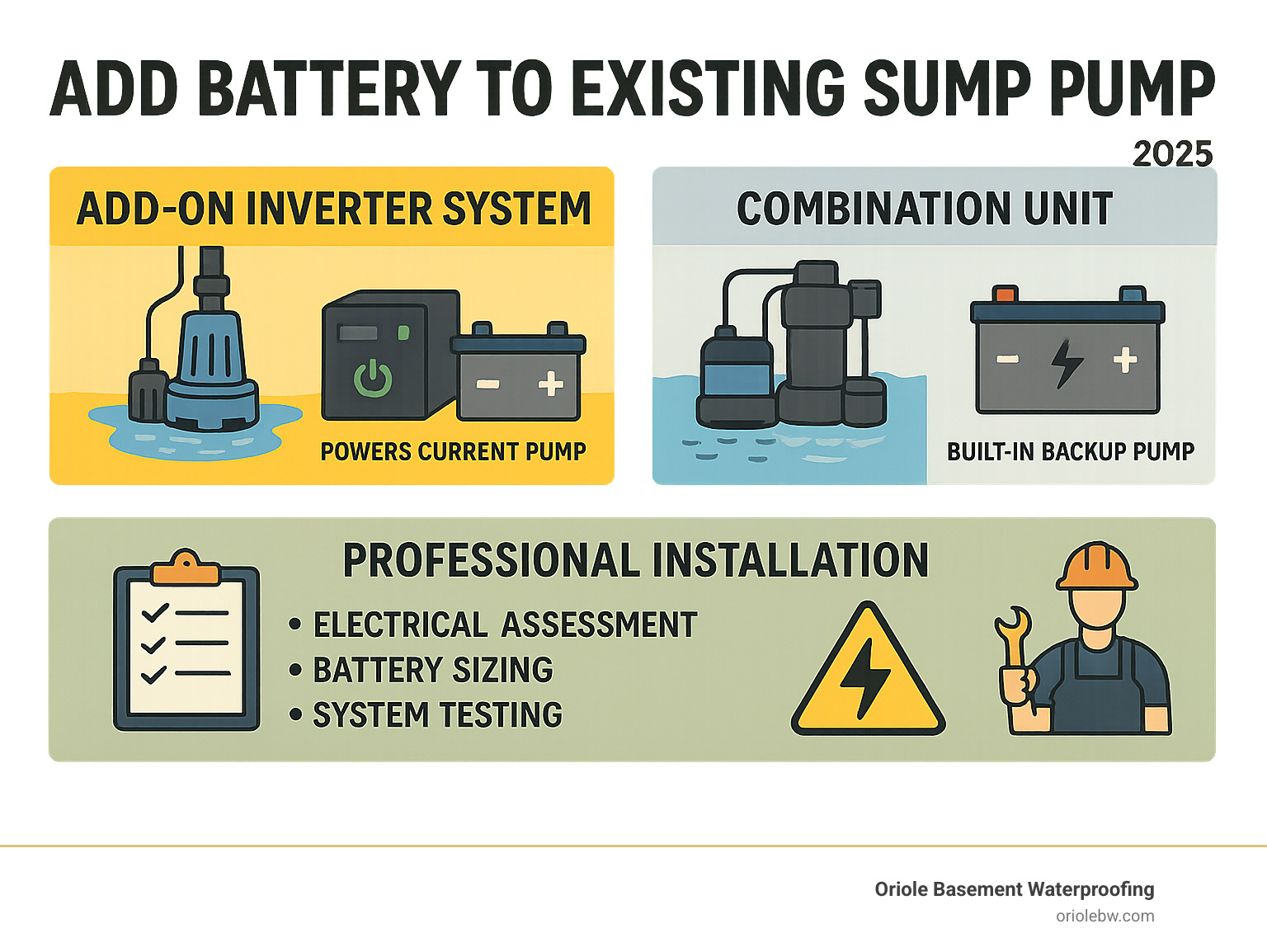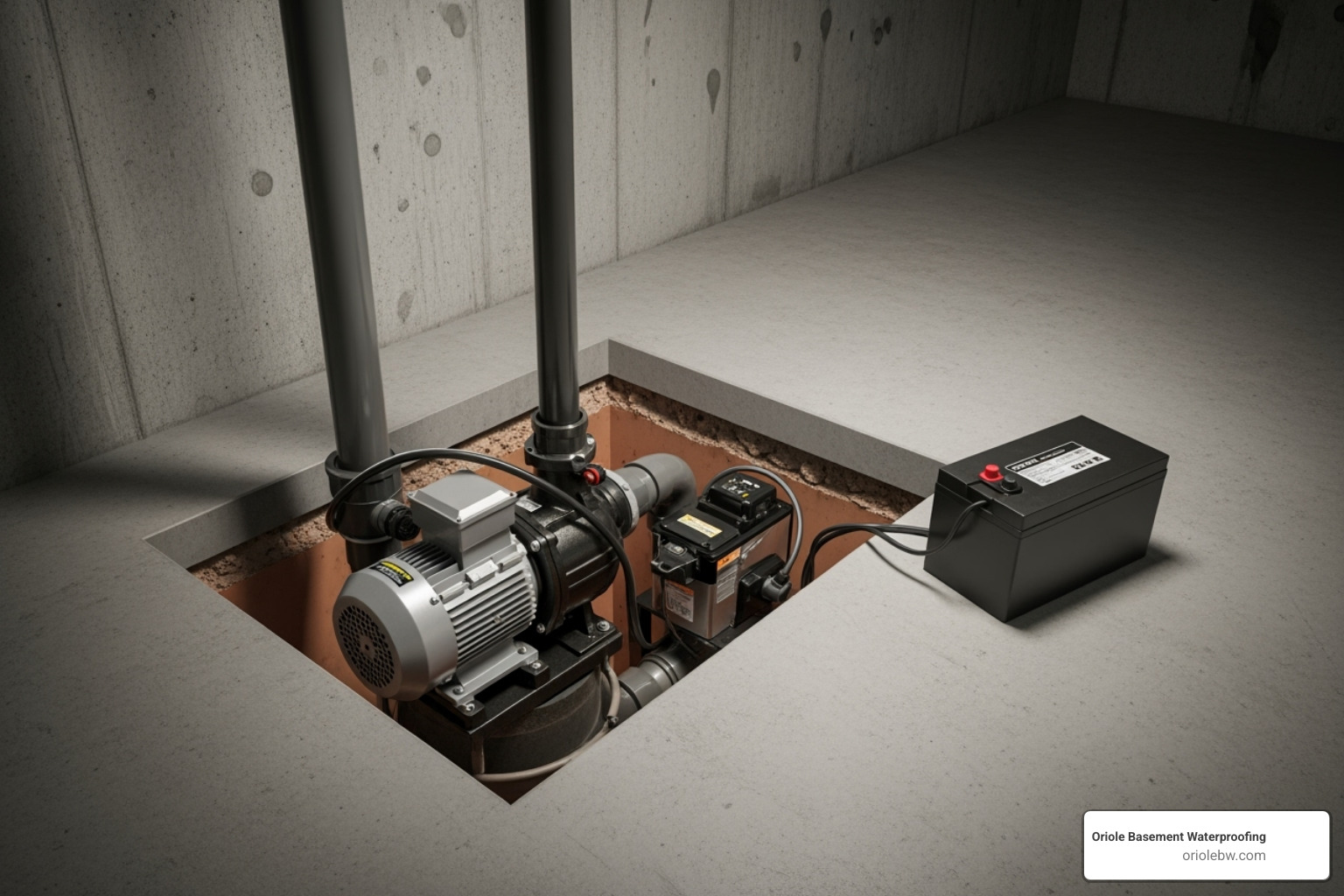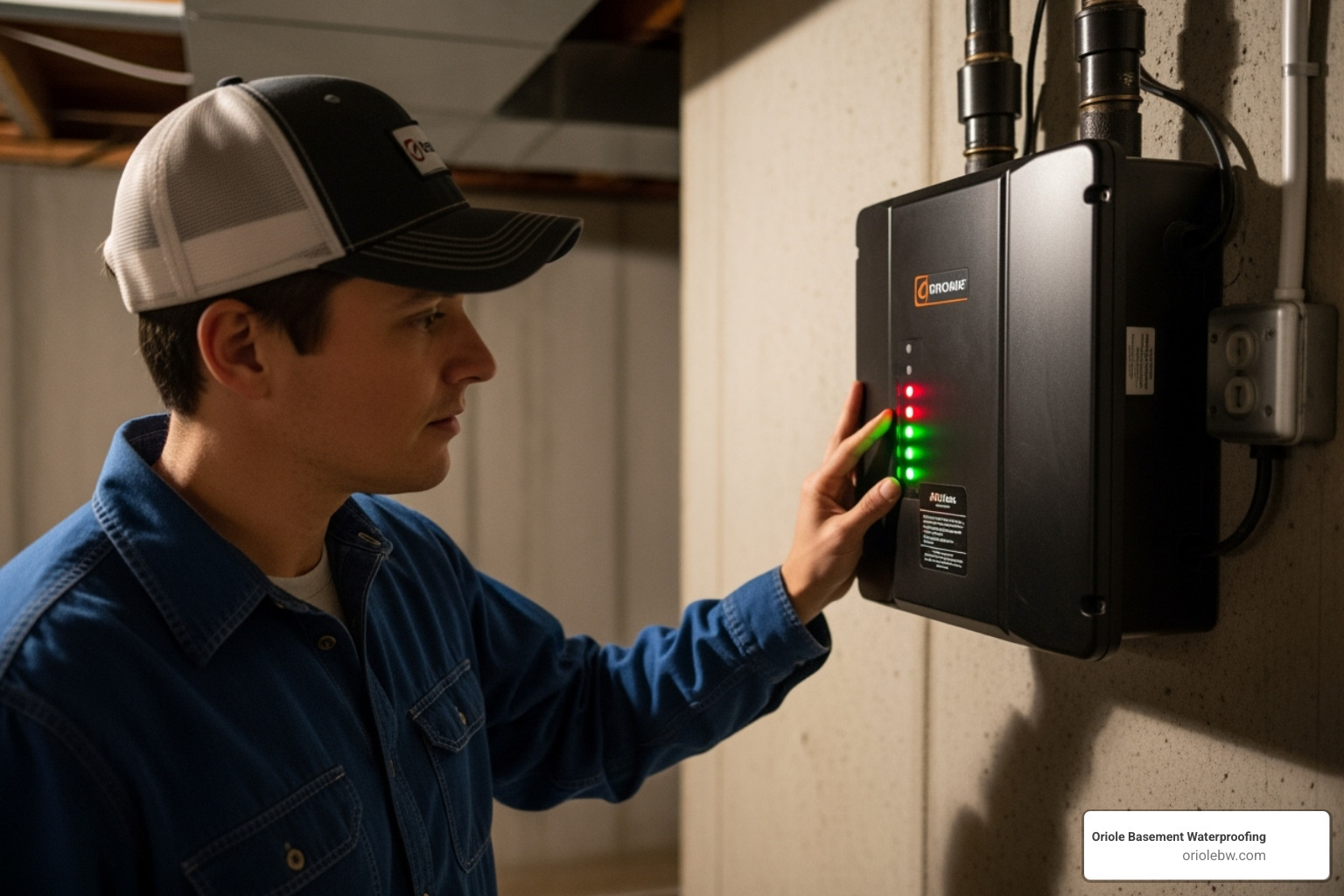Why Power Outages Turn Sump Pumps Into Expensive Paperweights
When you need to add battery to existing sump pump, you have several reliable options that can keep your basement dry even when the power goes out. Here’s what you need to know:
Quick Answer for Adding Battery Backup:
- Add-on systems – Connect to your current pump via an inverter unit
- Combination systems – Replace your pump with a dual primary/backup unit
- Professional installation – Ensures proper wiring, sizing, and safety
- Typical cost – $300-$700 for basic systems, more for high-capacity units
- Runtime – 5-53 hours depending on battery size and pump cycling
When a classic Maryland thunderstorm rolls through Baltimore County and the lights go dark, your sump pump falls silent. We’ve seen it happen countless times. A sump pump without power is just an expensive decoration in a hole, and with our region’s heavy rains, that’s a risk no homeowner should take.
Adding a battery backup to your existing sump pump isn’t just smart – it’s essential insurance for your home’s foundation and your peace of mind.

Why Your Sump Pump Needs a Trusty Sidekick
A sump pump without power is just a bucket in a hole. We’ve seen it for over 70 years across Maryland: a storm knocks out power for a few hours, and a basement floods. A battery backup is essential insurance for your home’s foundation.
The Main Reasons Sump Pumps Fail When You Need Them Most
Your pump works hard, but it tends to fail during the exact moments it’s needed most—when storms knock out power and water levels rise.

Common failure points include:
- Power outages: The number one reason pumps stop working during a storm.
- Stuck float switches: Debris or wear can jam the switch, preventing the pump from turning on or causing it to burn out.
- Overwhelmed pump: Intense storms can bring more water than your pump can handle.
- Mechanical wear: After years of service, motors and components break down.
- Clogged discharge lines: Debris, ice, or roots can block the pipe, sending water back into your basement.
- Electrical issues: A tripped circuit breaker or GFCI outlet can cut power to the pump unexpectedly.
Any of these issues can lead to thousands in damage. That’s why when we add battery to existing sump pump systems, we’re providing real protection. More info about sump pump services in Baltimore, MD.
What is a Sump Pump Battery Backup and How Does It Work?
Think of a battery backup as your sump pump’s vigilant bodyguard. It’s a smart system that ensures your pump never misses a beat.
When you add battery to existing sump pump systems, the backup unit plugs into a wall outlet, and your pump plugs into the backup. While power is on, the system charges its deep-cycle battery.
The instant the system detects a power loss, it automatically switches your pump to battery power in milliseconds. Your pump keeps running without interruption, protecting your basement.
Once power returns, the unit switches back to normal operation and recharges the battery, preparing for the next outage. It’s a simple concept that provides incredible protection, especially since severe weather and power outages often go hand in hand.
Not All Backup Systems Are Created Equal: Your Options
The Two Main Types of Battery Backup Systems We Offer
When you’re ready to add battery to existing sump pump, you have two solid paths forward. Both get the job done, but they work differently.

Add-on Battery Backup Systems are smart devices that give your current pump backup power. Your existing pump plugs into a control unit that contains an inverter, a charger, and connects to a deep-cycle battery. When the power goes out, this system instantly converts battery power to the AC electricity your pump needs. This is a great option if your primary pump is in good shape and you just need protection from power outages.
Combination Sump Pump Systems include both a primary AC-powered pump and a separate DC-powered backup pump in one system. The backup pump sits slightly higher in the sump pit. If the primary pump fails for any reason (power loss, mechanical issue, etc.), the water level rises and triggers the backup pump. This option provides comprehensive protection and makes sense if your current pump is older or you want the ultimate peace of mind.
Why We Recommend Battery Backups for Maryland & Pennsylvania Homes
After 70-plus years of keeping basements dry, we’ve landed firmly on battery backups. They are the most reliable option for our local conditions.
- They work instantly and automatically. The moment power goes out, your pump keeps running. No manual switching is needed.
- They’re completely independent. Unlike water-powered backups, they don’t rely on municipal water pressure, which can fail during a storm.
- There are no fumes or fuel. Generators require fuel, maintenance, and pose a carbon monoxide risk if not properly ventilated. Battery backups are clean and safe.
- Maintenance is straightforward. A few simple checks a year and a battery replacement every few years is all it takes.
Most importantly, battery systems are designed specifically to protect your sump pump – the one appliance that cannot fail during a storm.
How to Professionally Add a Battery to an Existing Sump Pump
Adding a battery to an existing sump pump seems simple, but it’s more than just plugging in a box. True protection requires seamless integration, proper safety measures, and reliability you can count on during a storm in Baltimore County. A professional assessment is crucial to avoid a DIY disaster that leaves you with a flooded basement.
Assessing Your Current Sump Pump and Electrical Setup
Before installation, our team performs a thorough assessment. Rushing this step is a recipe for failure.
- Pump Power: We check your pump’s horsepower (typically 1/3 or 1/2 HP) and its running vs. starting wattage. A 1/2 HP pump might run at 1,050 watts but need over 4,000 watts to start. The backup must handle this surge.
- Electrical System: We inspect your dedicated circuits and GFCI outlets to ensure they are safe and functioning correctly.
- Pump Condition: A backup system is only as good as the pump it’s protecting. If your pump is old or struggling, we may recommend replacing it for total system reliability.
- Sump Pit & Inflow: Understanding how quickly your pit fills helps us size the battery capacity for the runtime you actually need.
The Professional Installation Process: What to Expect
Our installation process is thorough because there’s no room for error when your basement is on the line.
- Mounting: We secure the unit and battery to a wall, off the floor and away from potential water.
- Connections: We use heavy-duty cables and ensure all connections are tight and corrosion-free. For combination units, we properly integrate the float switch.
- Ventilation: We ensure the area has adequate airflow for battery safety.
- Electrical: Our licensed technicians handle all wiring to meet local safety codes.
- Testing: We simulate a power outage to verify the system takes over seamlessly, discharges water properly, and that all alarms and indicators work.
View an example instruction manual for technical details.
Can I Add a Battery to an Existing Sump Pump Myself?
While DIY kits exist, the risks of installing a backup system yourself often outweigh the savings. Here’s why a pro is your best bet:
- Electrical Safety: Working with electricity and water is dangerous. Improper wiring can lead to shocks or fires.
- Sizing & Compatibility: Matching the backup to your pump’s power surge requirements is complex. A mismatch can damage your pump or fail to protect your home.
- Proper Installation: Correct mounting, ventilation, and float switch placement are critical for performance and longevity.
- Warranty: Our installations come with warranties on both the equipment and our workmanship, offering peace of mind a DIY project can’t.
A bad setup can lead to a flooded basement. Protecting your home’s foundation deserves professional expertise.
Key Considerations When You Add a Battery to an Existing Sump Pump
When you decide to add battery to existing sump pump, these details separate a system that truly protects your home from one that gives false confidence.

- Battery Capacity & Runtime: Measured in amp-hours (Ah), capacity determines runtime. A 40Ah battery might last 53 hours in light conditions but only 12 hours during a heavy storm. We help calculate the runtime you need.
- Alarm Features: Essential alerts for power loss, low battery, or system issues are critical. Some systems can even send text alerts.
- Battery Type: Standard deep-cycle batteries are affordable but need maintenance. AGM batteries are maintenance-free but cost more. We help you weigh the trade-offs.
- Charger & Inverter Quality: A multi-stage charger keeps your battery healthy, and a pure sine wave inverter runs your pump efficiently on battery power.
How Long Will a Battery Backup Last?
This is the most common question we get. The honest answer: it depends. A 40-amp-hour battery could power your pump for anywhere from 12 to 53 hours. The difference is how hard your pump has to work.
During a typical Maryland thunderstorm where your pump cycles every five minutes, you’ll get a longer runtime. During a major storm where it runs constantly, you’ll be closer to the 12-hour mark. We assess your home’s specific needs to recommend a system with enough capacity to handle typical storm-related outages in your neighborhood, which usually last 4 to 12 hours.
Simple Maintenance for Long-Term Reliability
Even the best system needs a little attention. These simple checks keep your system ready for action.
- Check Battery Water: For traditional lead-acid batteries, top off with distilled water every few months. (AGM and LiFePO4 batteries are maintenance-free).
- Clean Terminals: Twice a year, use a wire brush to clean terminals to ensure a solid connection.
- Test the System: Every three months, unplug the backup unit from the wall. Listen for the alarm, then pour water into the pit to ensure the pump kicks on. Plug it back in when done.
Frequently Asked Questions about Sump Pump Backups
Homeowners across our Maryland and Pennsylvania service areas often ask the same questions about sump pump backups. With over 70 years in the business, we have the answers. Here’s what you need to know when considering adding a battery to your existing sump pump.
How much power does my sump pump need?
Your sump pump is a power-hungry device. Most homes have a 1/3 or 1/2 horsepower pump. A 1/3 HP pump uses about 800 watts while running but can require up to 2900 watts to start. A 1/2 HP pump uses around 1050 watts but can surge to over 4100 watts on startup.
This startup surge is critical. If your battery backup can’t deliver enough power, your pump won’t turn on. We carefully calculate these requirements to ensure your backup system can handle the load.
Is a battery backup still needed if I have a whole-house generator?
Yes, absolutely. A dedicated battery backup is still essential for two main reasons:
- It’s Instant: A generator takes several seconds to start. In a downpour, those seconds can be enough for water to enter your basement. A battery backup provides seamless, instantaneous power.
- It’s a Failsafe: Generators can fail, run out of fuel, or require maintenance. A battery backup is an independent safety net dedicated solely to your sump pump.
Think of it as a backup for your backup. When protecting your foundation, redundancy is smart planning.
How often should the backup battery be replaced?
The typical deep-cycle battery in a backup system should be replaced every 3 to 5 years to ensure it holds a reliable charge. This can vary based on usage frequency and battery type (AGM or LiFePO4 batteries may last longer).
Don’t wait for a storm to find out your battery is dead. We recommend checking the battery’s condition during annual sump pump inspections and replacing it proactively. It’s better to replace a battery on a sunny day than to find it has failed during a power outage.
Your First Step Toward a Flood-Proof Basement
A power outage shouldn’t mean panic about your basement flooding. Adding a battery to your existing sump pump is one of the smartest investments to prevent costly water damage in your Maryland or Pennsylvania home. It’s not a matter of if a storm will knock out power, but when. A backup system ensures you’re prepared.
This is a cornerstone of a complete foundation protection plan. A wet basement can lead to serious foundation problems, compromising your entire home’s stability. At Oriole Basement Waterproofing, we bring over 70 years of experience to every job, helping families avoid that nightmare.
Our solutions are about preventing tomorrow’s disasters, not just fixing today’s problems. We stand behind our work with a lifetime transferable guarantee on major repairs. Our white-glove service means our certified technicians keep you informed from the free inspection to the final system test.
Don’t wait for the next storm to roll through Baltimore or Lancaster County. Let our team fortify your home’s defenses with a professionally installed battery backup system sized perfectly for your needs.
Oriole Basement Waterproofing: 70+ years of experience, lifetime warranty, professional assessment, and expert installation.
Protect your Baltimore home with a reliable sump pump battery backup system.






